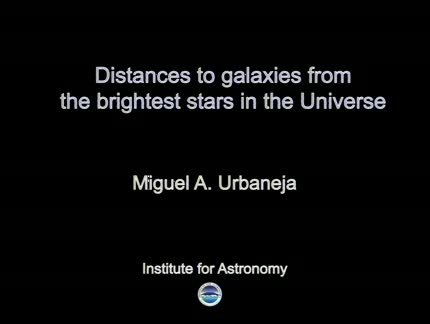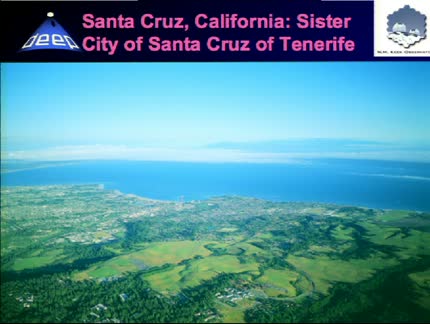Found 7 talks width keyword distances and redshifts

Abstract
The Major Atmospheric Gamma-ray Imaging Cherenkov (MAGIC) telescopes reported the discovery of the most distant gamma-ray source ever observed at very high energies, thanks to the “replay” of an enormous flare by a galactic gravitational lens as foreseen by Einstein’s General Relativity. QSO B0218+357 is a gravitationally lensed blazar located at a redshift of 0.944. The gravitational lensing splits the emitted radiation into two components separated by a 10–12 day delay. In July 2014, QSO B0218+357 experienced a violent flare observed by the Fermi-LAT and followed by the MAGIC telescopes. The spectral energy distribution of QSO B0218+357 can give information on the energetics of z ~ 1 very high energy gamma-ray sources. Moreover the gamma-ray emission can also be used as a probe of the extragalactic background light at z ~ 1. MAGIC performed observations of QSO B0218+357 during the expected arrival time of the delayed component of the emission. The MAGIC and Fermi-LAT observations were accompanied by quasi-simultaneous optical data from the KVA telescope and X-ray observations by Swift-XRT. We construct a multiwavelength spectral energy distribution of QSO B0218+357 and use it to model the source. The GeV and sub-TeV data obtained by Fermi-LAT and MAGIC are used to set constraints on the extragalactic background light. Very high energy gamma-ray emission was detected from the direction of QSO B0218+357 by the MAGIC telescopes during the expected time of arrival of the trailing component of the flare, making it the farthest very high energy gamma-ray source detected to date. The combined MAGIC and Fermi-LAT spectral energy distribution of QSO B0218+357 is consistent with current extragalactic background light models. The broadband emission can be modeled in the framework of a two-zone external Compton scenario, where the GeV emission comes from an emission region in the jet, located outside the broad line region.
Work published in A&A 595, A98 (2016) ( http://www.aanda.org/articles/aa/abs/2016/11/aa29461-16/aa29461-16.html)
https://magic.mpp.mpg.de/outsiders/results/magic-highlights-5/
http://www.iac.es/divulgacion.php?op1=16&id=1133

Abstract
Measuring distances to galaxies and determining their chemical compositions are two fundamental activities in modern extragalactic astronomy, in that they help characterizing the physical properties of their constituents and their evolutionary status. Ultimately, these measurements lead to stronger constraints on the cosmological parameters of an expanding universe and the history of cosmic chemical enrichment. Both these questions can be tackled afresh with the quantitative analysis of the absorption line spectra of individual massive and luminous, young B- and A-type supergiant stars. A spectroscopic distance determination method, the FGLR, can yield accurate distances up to several Mpc, extending to a local volume where the results can be compared with those obtained from Cepheids and other distance indicators. Moreover, and this being a unique advantage of the FGLR, reddening values and metallicities are simultaneously determined for each individual stellar target. These stellar metallicities are very accurate and can be used to constrain the formation and evolution of galaxies and to assess and overcome the systematic uncertainties of H II region strong-line abundances through a galaxy-by-galaxy comparison. Moreover, stellar spectroscopy provides fundamental complementary abundance information for star forming galaxies on additional atomic species such as iron-group elements. I will present recent results of our on-going efforts to study individual blue supergiant stars in galaxies within and beyond the Local Group based on medium and low resolution optical spectra collected with ESO VLT and the Keck telescopes. The promising perspectives of future work, based on the giant ground-based telescopes of the next generation (E-ELT, TMT) are also discussed.

Abstract
We present recent theoretical and empirical results concerning the accuracy of Cepheid distance estimates based on optical and near-infrared (NIR) Period-Luminosity (PL) relations. In particular, we plan to discuss the dependence of both slope and zero-point on the metal content using a large sample of extragalactic Cepheids. Moreover, we discuss pros and cons of optical and NIR reddening free Period-Wesenheit relations. We also mention the impact that GAIA will have on the precision of the Cepheid distance scale and the role that E-ELT will play in the identification of Cepheids beyond the Local Volume.
Abstract
Survey operations with the VISTA telescope with it wide field near IR camera started in Feb 2010, following a science verification phase that started in Oct, 2009. I will describe this new 4.2m wide field telescope and the ESO VISTA Public survey program. I will give details of all ESO six public surveys which will be used for a range of galactic and extragalactic science. I am the PI of the largest, by area, VISTA survey, I will focus my talk on the VISTA Hemisphere Survey and I will show how this survey will be used to find quasars in the Epoch of Reionization at redshift greater than 7. The VISTA Hemisphere Survey (VHS) has been been awarded 300 clear nights on the 4.2m ESO VISTA telescopes. VHS observations started i February, 2010 and the survey will take 5 years to complete. The VHS will cover the whole southern celestial hemisphere (dec<0) to a depth 4 magnitudes fainter than 2MASS/DENIS in at least two wavebands J and K. In the South Galactic Cap, 5000 square degrees will be imaged deeper, including H band, and will have supplemental deep multi-band grizY imaging data provided by the Dark Energy Survey (DES). The remainder of the high galactic latitude sky will be imaged in YJHK and combined with ugriz wavebands from the VST ATLAS, SDSS BOSS and Skymapper optical surveys. The medium term scientific goals include: a huge expansion in our knowledge of the lowest-mass and nearest stars; deciphering the merger history and genesis of our own Galaxy; measurement of large-scale structure out to z=1 and measuring the properties of Dark Energy; discovery of the first quasars with z > 7. In my talk, I will describe the scientific motivation and methodology of the search for quasars with z > 7.
Abstract
AEGIS (All-wavelength Extended Groth strip International Survey: aegis.ucolick.org) is on-going survey that opens up new views of the development of galaxies and AGN's at redshifts z about 1. AEGIS is panchromatic like GOODS, with coverage ranging from X-ray to radio, and nearly as deep but more panoramic by covering a 4x larger region. Its backbone is the most Northern (accessible to the GTC) of the four fields of the DEEP2 Keck spectroscopic survey, which provides not only precision redshifts that yield reliable pairs, groups, and environments, but also internal kinematics and chemical abundances. After an overview of the DEEP and AEGIS surveys, I will share some recent highlights, including using a new kinematic measure for distant galaxies to track Tully-Fisher-like evolution; discovering metal poor, massive, luminous galaxies; finding ubiquitous galactic gas outflows among distant star forming galaxies; and exploring the nature of distant x-ray AGNs.
Abstract
Peculiar velocities of galaxies, derived using distance estimators, are plagued with systematic effects and are unreliable beyond 100 Mpc/h. In Kashlinsky & Atrio-Barandela (2000) we proposed to measure peculiar velocities of clusters of galaxies using the temperature anisotropies on the Cosmic Microwave Background generated by the hot X-ray emitting. Using this technique we have recently found a bulk flow velocity of amplitude 600-1000 km/s in the same direction as the CMB dipole and encompassing a sphere of 300 Mpc/h radius. We shall discuss the cosmological implications of this measurement.
Abstract
The amount of baryons seen in the local Universe falls short by a factor2-5 if compared to the amount of detected baryons at intermediate (z~2)or high (z~1,100) redshift. This is the so called "missing baryon" problem in Cosmology. Hydrodynamical simulations of the large scale structure predict that most of those missing baryons should be in the form of ionized gas present in slightly overdense regions, at a temperature ranging from 10^5 to 10^7 K, conforming the "Warm Hot Intergalactic Medium" (WHIM). This WHIM would not form stars, and would not emit or absorb either in the IR, optical or UV. However, it should interact with the photons of the Cosmic Microwave Background (CMB) through two different channels: (i) Thompson scattering (where there is no energy exchange) and (ii) Compton scattering (where hot electrons transfer energy to the CMB photons, distorting their black body spectrum). I shall review the status of the search for missing baryons in the context of CMB observations and the currently most favored cosmological model. I shall also outline new methods and prospects for detecting this missing gas with upcoming CMB experiments and address the link between the cosmic baryon problem and the search for (so far undetected) bulk flows at scales of ~10 Mpc/h.« Newer Older »
Upcoming talks
- EMO-1: Construyendo un observatorio caseroEnol Matilla BlancoFriday April 19, 2024 - 10:30 GMT+1 (Aula)








